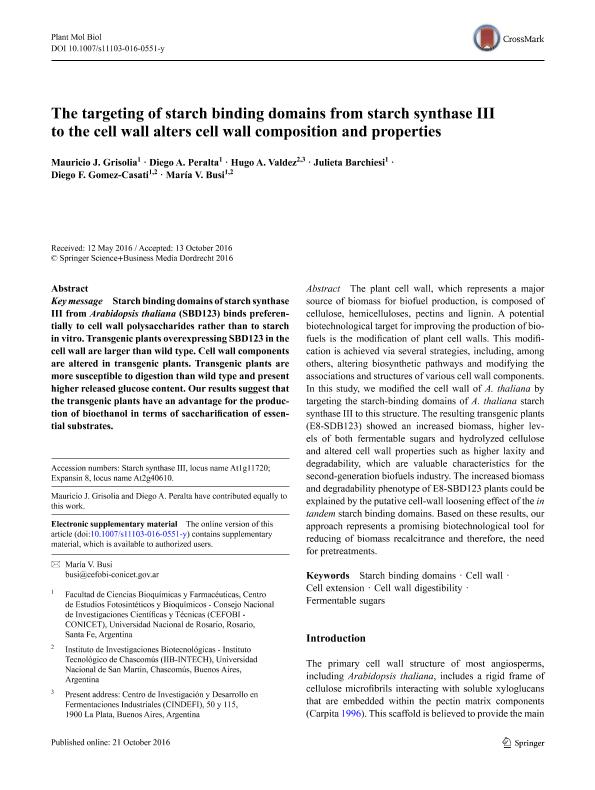Artículo
The targeting of starch binding domains from starch synthase III to the cell wall alters cell wall composition and properties
Grisolía, Mauricio Javier ; Peralta, Diego Alberto
; Peralta, Diego Alberto ; Valdez, Hugo Alberto
; Valdez, Hugo Alberto ; Barchiesi, Julieta
; Barchiesi, Julieta ; Gomez Casati, Diego Fabian
; Gomez Casati, Diego Fabian ; Busi, María Victoria
; Busi, María Victoria
 ; Peralta, Diego Alberto
; Peralta, Diego Alberto ; Valdez, Hugo Alberto
; Valdez, Hugo Alberto ; Barchiesi, Julieta
; Barchiesi, Julieta ; Gomez Casati, Diego Fabian
; Gomez Casati, Diego Fabian ; Busi, María Victoria
; Busi, María Victoria
Fecha de publicación:
10/2016
Editorial:
Springer
Revista:
Plant Molecular Biology
ISSN:
0167-4412
e-ISSN:
1573-5028
Idioma:
Inglés
Tipo de recurso:
Artículo publicado
Clasificación temática:
Resumen
The plant cell wall, which represents a major source of biomass for biofuel production, is composed of cellulose, hemicelluloses, pectins and lignin. A potential biotechnological target for improving the production of biofuels is the modification of plant cell walls. This modification is achieved via several strategies, including, among others, altering biosynthetic pathways and modifying the associations and structures of various cell wall components. In this study, we modified the cell wall of A. thaliana by targeting the starch-binding domains of A. thaliana starch synthase III to this structure. The resulting transgenic plants (E8-SDB123) showed an increased biomass, higher levels of both fermentable sugars and hydrolyzed cellulose and altered cell wall properties such as higher laxity and degradability, which are valuable characteristics for the second-generation biofuels industry. The increased biomass and degradability phenotype of E8-SBD123 plants could be explained by the putative cell-wall loosening effect of the in tandem starch binding domains. Based on these results, our approach represents a promising biotechnological tool for reducing of biomass recalcitrance and therefore, the need for pretreatments.
Palabras clave:
Starch Binding Domains
,
Cell Wall
,
Cell Extension
,
Cell Wall Digestibility
Archivos asociados
Licencia
Identificadores
Colecciones
Articulos(CEFOBI)
Articulos de CENTRO DE EST.FOTOSINTETICOS Y BIOQUIMICOS (I)
Articulos de CENTRO DE EST.FOTOSINTETICOS Y BIOQUIMICOS (I)
Articulos(CINDEFI)
Articulos de CENT.DE INV EN FERMENTACIONES INDUSTRIALES (I)
Articulos de CENT.DE INV EN FERMENTACIONES INDUSTRIALES (I)
Citación
Grisolía, Mauricio Javier; Peralta, Diego Alberto; Valdez, Hugo Alberto; Barchiesi, Julieta; Gomez Casati, Diego Fabian; et al.; The targeting of starch binding domains from starch synthase III to the cell wall alters cell wall composition and properties; Springer; Plant Molecular Biology; 93; 1-2; 10-2016; 121-135
Compartir
Altmétricas



